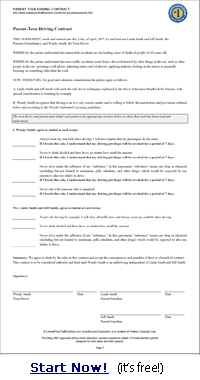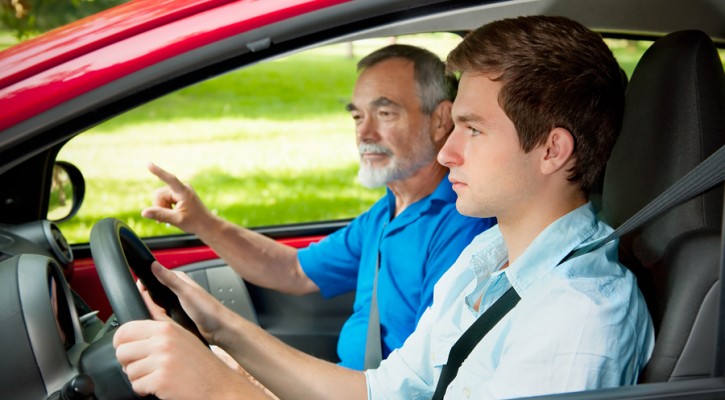
How to Use a Teen Driving Contract
April 27, 2009
Teaching your teen to drive safely is one of your most important responsibilities as a parent, and training shouldn’t end when your teen gets a driver’s license.
The early years of driving are a dangerous time for teens. Almost 40% of all deaths for 16- to 19-year-olds occur in motor vehicle crashes; drivers in this age group are four times more likely to be involved in a crash than older drivers.
Setting and enforcing limits on your teen’s driving privileges will help keep your teen safe while reinforcing that driving is a serious matter. Be sure to set limits that comply with your state’s Graduated Driver’s Licensing laws. A Parent-Teen Driving Contract can help you ensure that your teen knows the rules in your household for getting and maintaining driving privileges and the penalties for breaking those rules.
Completing a Parent-Teen Driving Contract will be most effective if the concept and expectation are presented in advance (preferably at age 14). Make sure your teen understands that she or he will not be allowed to drive until an agreement is reached and both parties have signed the contract and initialed each term presented in it. Start a dialogue early about what the terms might include. Set aside at least thirty minutes to review the contract together before you and your teen sign it. Post the contract in a conspicuous place in your home so you and your teen can review it frequently.
How to Use the Teen Driving Experience Log Book
April 23, 2009
One of the Graduated Driver Licensing requirements for a Florida Operator’s License is that the holder of the Learner’s License must have a parent or guardian certify that the driver has had at least 50 hours of experience behind the wheel, ten hours of which must have been at night.
Many parents sign the affidavit without much thought, knowing that they must have accumulated at least 50 hours while teaching their teen to drive. But it’s important to maximize the training quality of these hours. The best way to do this is with a Teen Driving Experience Log Book.
The Driving Experience log helps both the parent and the teen driver ensure that the teen is trained on a wide range of driving skills in a variety of conditions. Here are the components of the log and how to use them:
- Date: Try to space driving lessons two to three days apart. This gives the teen driver enough -time to process the lesson without causing learning fatigue. Try not to let too much time go by between lessons (for example, letting your teen practice driving only on weekends).
- Vehicle: Try to conduct driving lessons in at least two different vehicles, even if your teen will only be using one of the family cars after being licensed. Teen drivers need to understand the differences between accelerating, steering, and braking different vehicles.
Teach your teen to spend a few minutes getting familiar with the location of the gearshift, headlights, defroster, windshield wipers, and gauges when you conduct training in a new vehicle.
- Route: Resist the temptation to allow your teen to practice driving only on familiar routes close to home (for example, to and from the nearest grocery store). While it is important to conduct training in these areas, your teen will likely be driving farther from home soon after being licensed. Expand routes to include challenging roads, such as expressways, as your teen gains experience and skill.
- Practiced: Just as with routes, new drivers should practice a variety of maneuvers. For example, teens should practice parallel parking on downtown streets as well as straight-in parking in shopping center parking lots. They need to learn how to make three-point turns, how to drive in a roundabout, and how to pull safely off the road if the vehicle overheats. Parents who are having trouble creating diverse lesson plans should consult a resource such as the National Safety Commission’s Driver Education Handbook for Parents.
- Weather: Parents may be hesitant to ride with an inexperienced driver on slippery roads, but new drivers will eventually have to contend with driving in inclement weather conditions. They should get this experience while a parent is still present to provide guidance. Most teens are not capable of comprehending the risks of reduced visibility and hydroplaning on their own.
- Remarks: This is a good place to make note of routes and maneuvers with which the teen driver needs additional practice. Staggering lessons so the teen is not practicing the same complicated concepts in consecutive sessions will reduce frustration for both parties.
- Prep Time: Teach your teen driver to conduct a pre-trip inspection of the vehicle. Record this time and lecture time (keep lectures short to compensate for teens’ short attention spans) here.
- Actual Driving Time: End each training session when you sense that you and/or your teen are approaching fatigue, but try to end each lesson on a positive note. If your teen struggles during a lesson, spend the final few minutes practicing a technique she or he already does well.
- Day Driving Time; Night Driving Time: The 50 hours of driving experience including ten hours at night required by the GDL law is a minimum. You are the best judge of how much training your teen needs to be a safe driver.
- Debrief Time: Calmly discuss your teen’s progress. Be sure to allow your teen to give feedback. Reassure your teen that you will continue practicing difficult maneuvers and offer praise for her or his successes.
Teaching their teen to drive is a stressful, emotional experience for many parents, but making training time count is one of the most important things you will ever do for your child.
Prepping for a Safe Prom: Talking to Teens
April 22, 2009
Prom season is fast approaching and many parents are busy helping their teens buy dresses or rent tuxedos, select corsages and boutonnieres, and choose formal hairstyles. But prom preparation should also include frequent, specific, and frank discussions with teens about how to stay safe and avoid alcohol on prom night. Here are some tips on what to discuss:
- First, talk to other parents; then, talk to your teen about their friends’ parents. Being part of your social group is no guarantee that other parents espouse a zero-tolerance policy for alcohol. You might be surprised to discover that other parents plan to provide their teens and their friends with alcohol in a “safe” manner and location. Though this is illegal in every state, it is a relatively common occurrence. If any of your teen’s friends’ parents plan to provide alcohol or “look the other way,” reinforce your own house rules about alcohol with your teen. Make sure they understand that underage drinking is never acceptable, no matter what any other parent says or does, even for a special occasion. Make sure your teen will be riding with friends whose parents do not permit the use of alcohol. Try to organize an after-prom party for your teen with other teens’ parents who have a zero-tolerance policy for alcohol and are willing to help chaperone.
- Next, create a code. Your teen must be able to signal for help without risking the ridicule of friends. If you haven’t started texting with your teen, this is a good time to practice. Texting is an easy, unobtrusive way for your teen to check in with you frequently throughout the evening. Your teen might say or text, “Dinner was awesome!” as a code for “Please come get me.” When you arrive to pick up your teen, she or he can blame you for having to leave or you can give the excuse of a “family emergency.” Make an agreement with your teen that if you do have to pick the teen up, a discussion about the reason can be tabled until the next morning, when you and your teen are both calm and safe. Otherwise, teens may avoid calling parents for help because they don’t want their parents to know about the circumstances that required the ride home.
- Make a record of your teen’s planned itinerary for the evening, and require your teen to inform you of any changes. Be alert to spontaneous changes in plans on the night of the prom; your teen won’t have as much control over the situation if it takes place in an unfamiliar location and/or with people she or he doesn’t know well. In the excitement of the evening, your teen might not anticipate difficulties and could end up in a risky situation before she or he realizes what is happening. You’ll need to check in more frequently in case your teen needs extra guidance.

How to Use a Teen Driving Checklist
April 14, 2009
Teaching their teen to drive is a stressful experience for many parents. The parent is nervous about the teen driver’s safety, while the teen is giddy with excitement. Parents may be ambivalent about this rite of passage because it means their child is growing up, while teens are eager for the new level of freedom and independence associated with a driver’s license. The parent wants the teen to absorb as much information about the driver training process as possible; the teen just wants to learn enough to pass the road test.
One way to manage driver training sessions is to use a Teen Driving Checklist. The checklist provides an opportunity to review concepts and provide feedback on the driving lesson. Using this tool provides structure to each lesson, which facilitates learning for the teen and helps the parent feel more comfortable about the process of teaching the teen to drive.
The parent should complete one copy of the checklist during each lesson. Before the parents share it with the teen at the end of the lesson, the teen can complete a second copy of the evaluation. This self-evaluation helps teens learn to assess the driving behavior of themselves and other drivers, a critical concept once they are out on the road on their own. After the teen finishes the self-assessment, the two checklists should be compared and discussed in detail.
Parents should be sure to acknowledge areas of improvement as well as make a note of skills that need further discussion and practice. If the driving lesson was particularly difficult, parents can wait a few hours to have the discussion, but it should take place prior to the next driving lesson so the teen won’t continue to practice bad habits.
Since the checklist includes basic, intermediate, and advanced skills, parents can easily tailor each driving lesson to a specific set of skills. Avoid packing too much into one driving lesson, which could overwhelm the teen driver. It is better to hold a few extra lessons than to take a chance on skimping on a teen driver’s knowledge of critical driving skills.

Graduated Driver Licensing Laws: A Comparison
April 8, 2009
A national model for Graduated Driver Licensing Programs has existed since the mid 1990s. The model provides guidelines for states to create their own GDL programs. Currently, no state follows all the guidelines, and GDL programs vary widely from state to state.
The recommended guidelines are:
Stage 1: Learner’s Permit
- State sets minimum age for a learner’s permit at no younger than age 16;
- Pass vision and knowledge tests, including rules of the road, signs, and signals;
- Completion of basic driver training;
- Licensed adult (who is at least 21 years old) required in the vehicle at all times;
- All occupants must wear seat belts;
- Teenage-passenger restrictions;
- Zero alcohol while driving;
- Permit is visually distinctive from other driver licenses;
- Must remain crash and conviction free for at least six months to advance to next level;
- Parental certification of 30 to 50 practice hours; and
- No use of portable electronic communication and entertainment devices.
Stage 2: Intermediate (Provisional) License
- Completion of Stage 1;
- State sets minimum age of 16.5;
- Pass a behind the wheel road test;
- Completion of advanced driver education training (safe driving decision-making, risk education, etc.)-All occupants must wear seat belts;
- Licensed adult required in the vehicle from 10 p.m. until 5 a.m. (e.g., nighttime driving restriction);
- Zero alcohol while driving;
- Driver improvement actions are initiated at lower point level than for regular drivers;
- Provisional license is visually distinctive from a regular license;
- Teenage-passenger restrictions: not more than one teenage passenger for the first 12 months of intermediate license. Afterward, limit the number of teenage passengers to two until age 18;
- Must remain crash and conviction free for at least 12 consecutive months to advance to the next stage;
- Supervised practice; and
- No use of portable electronic communication and entertainment devices.
Stage 3: Full Licensure
- Completion of Stage 2;
- State sets minimum age of 18 for lifting passenger and nighttime restrictions; and
- Zero alcohol while driving.
Source: National Highway Traffic Safety Administration
To understand the range of differences among states, let’s examine the GDL laws of four states: California, Florida, Mississippi, and North Dakota.
The NHTSA recommends that the state sets the minimum age for a learner’s permit at no younger than age 16. In California, the minimum age for a learner’s permit is 15 years, six months; in Florida and Mississippi, the minimum age is 15. The minimum age in North Dakota is 14.
Before getting a license or restricted license in Florida, new drivers must have a mandatory holding period of the learner’s license of twelve months; the other three states require six months. In Mississippi, license applicants age 17 and older are exempt from the holding period. The NHTSA recommends an intermediate (provisional) stage with a minimum age of 16.5. The applicant must remain crash and conviction free for at least six months to advance from the learner’s permit to the intermediate level. They further recommend that in the intermediate license stage, the applicant must remain crash and conviction free for at least 12 consecutive months to advance to full licensure.
The NHTSA recommends parental certification of 30 to 50 practice hours of driving in the learner’s permit stage. While California and Florida each require 50 hours, 10 of which must be at night, neither Mississippi nor North Dakota require certification of any driving practice hours.
Applicants in Mississippi must be age 15 years, six months before getting a license or restricted license. Florida, North Dakota, and California require a minimum age of 16; however, in California, license applicants who do not take driver education must wait until age 18 for a license. The NHTSA recommendation is for full licensure only after completion of the intermediate licensing stage, with a minimum age of 18 for lifting passenger and nighttime restrictions. However, North Dakota does not have any passenger or nighttime restrictions, and Florida and Mississippi have only nighttime restrictions. California’s passenger restriction is that for the first 12 months, the restricted driver may have no passengers younger than 20, with limited exceptions for immediate family.
One way to improve the traffic crash figures for teenage drivers is to advocate for stronger Graduated Driver Licensing requirements in your state. In the meantime, you can reduce the risks for your own children by ensuring that they obey existing GDL laws and by implementing some of the NHTSA’s guidelines into your own house rules if your state has relatively weak GDL laws.
